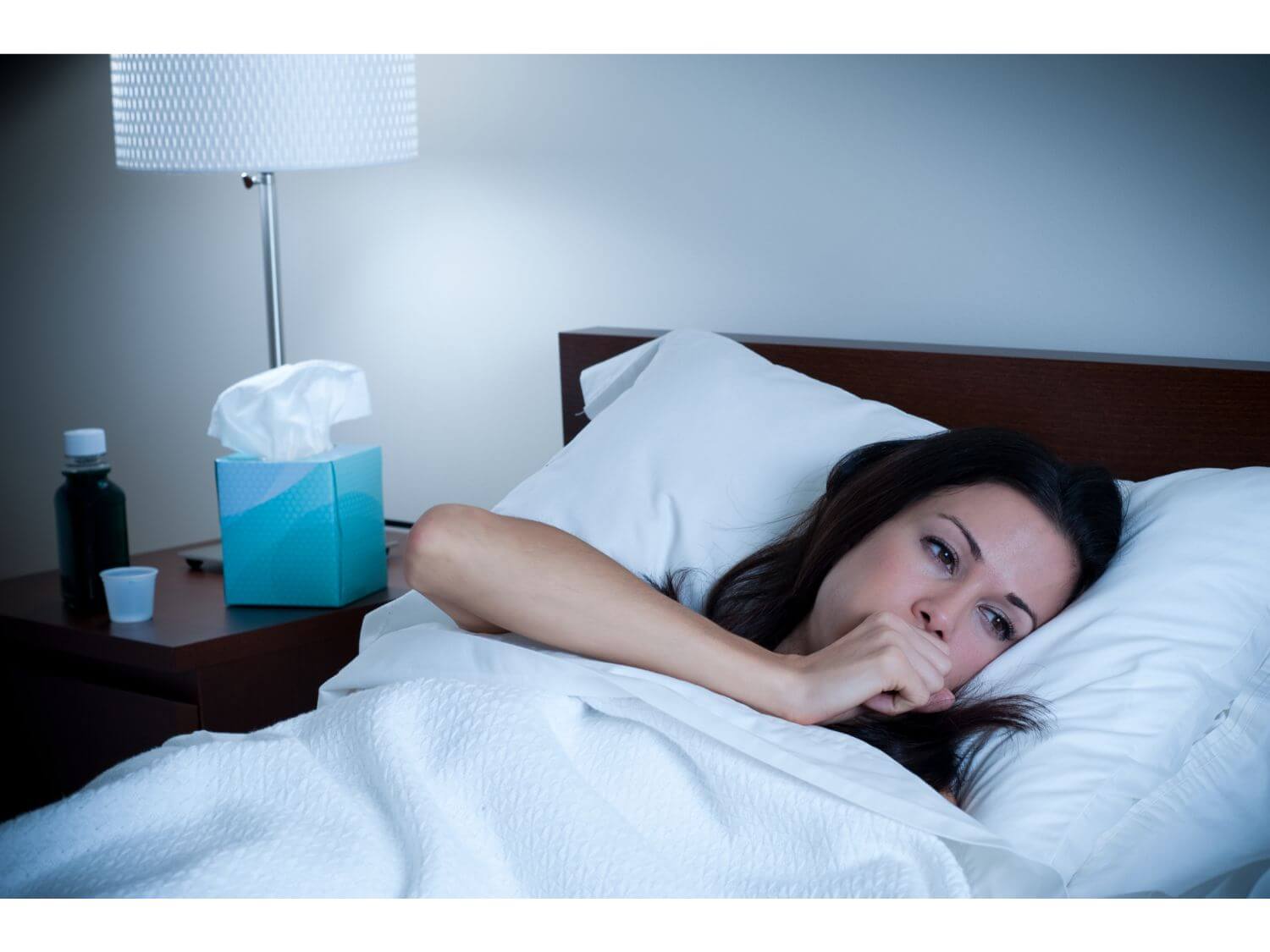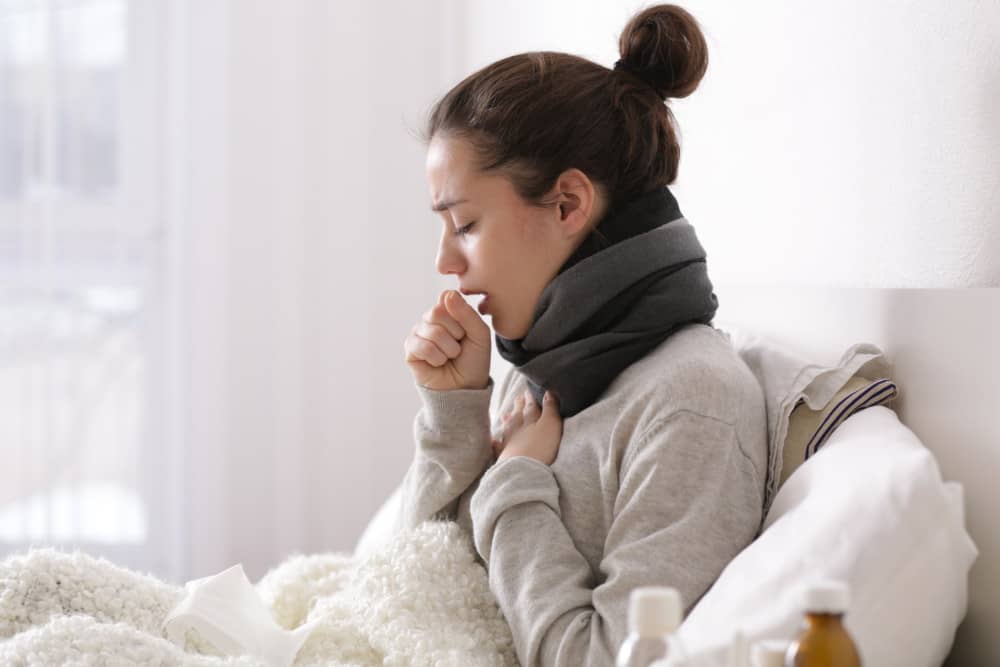What is whooping cough?
Note: If you have a new or ongoing cough, a high temperature (fever) or you've noticed a change in your sense of smell or taste, you may have coronavirus (COVID-19). Read more about coronavirus or use our Coronavirus Risk Assessment to check your risk.
Whooping cough is a highly contagious bacterial infection of the lungs and airways.
The medical term for whooping cough is pertussis.
The condition usually begins with a persistent dry and irritating cough that progresses to intense bouts of coughing. These are followed by a distinctive 'whooping' noise, which is how the condition gets its name.
Other symptoms include a runny nose, raised temperature and vomiting after coughing.
The coughing can last for around three months (another name for whooping cough is the ‘hundred day cough’).
Read more about the symptoms of whooping cough.
Whooping cough is caused by a bacterium called Bordetella pertussis, which can be passed from person to person through droplets in the air from coughing and sneezing.
Read more about the causes of whooping cough.
Treating whooping cough
If whooping cough is diagnosed during the first three weeks (21 days) of infection, a course of antibiotics may be prescribed. This is to prevent the infection being passed on to others.
It is important to take steps to avoid spreading the infection to others, particularly babies under six months of age.
Children with whooping cough should be kept away from school or nursery for five days from the time they start taking a prescribed course of antibiotics. The same advice applies to adults returning to work.
As a precaution, household members of someone with whooping cough may also be given antibiotics and a booster shot of the vaccine.
Antibiotics will not usually be prescribed in cases where whooping cough is not diagnosed until the later stages of infection (2-3 weeks after the onset of symptoms).
By this time, the Bordetella pertussis bacterium will have gone so you will no longer be infectious. It is also very unlikely that antibiotics will improve your symptoms at this stage.
Your doctor will be able to advise you about how to manage the infection at home using some simple self care measures, such as resting and drinking plenty of fluids to avoid dehydration.
Read more about treating whooping cough.
Babies under the age of six months are likely to be admitted to hospital as they are most at risk of severe complications, such as serious breathing difficulties.
They will be treated in isolation to prevent the infection spreading and will be given antibiotics into a vein through a drip (intravenously).
Read more about the complications of whooping cough.
Whooping cough vaccination
Read more about preventing whooping cough.
Although the number of cases of whooping cough has fallen dramatically since vaccination began, it is still possible for children to get the infection, so having the vaccination is vital.
The more people vaccinated against whooping cough the less chance there is of them passing on the infection to a young baby in which it could cause serious, and possibly fatal, complications.
The effectiveness of the whooping cough vaccination may fade over time, meaning it is possible to develop the condition during adulthood if you were previously vaccinated.
Who is affected?
Most cases occur in adults whose immunity has faded and in these cases symptoms tend to be less serious (although having to live with a persistent cough can be frustrating and unpleasant).
Whooping cough symptoms
The symptoms of whooping cough usually take between six and 20 days to appear after infection with the Bordetella pertussis bacterium. This delay is known as the incubation period.
Whooping cough tends to develop in stages, with mild symptoms occurring first, followed by a period of more severe symptoms, before improvement begins.
Early symptoms
The early symptoms of whooping cough are often similar to those of a common cold and may include:
- runny or blocked nose
- sneezing
- watering eyes
- dry, irritating cough
- sore throat
- slightly raised temperature
- feeling generally unwell
These early symptoms of whooping cough can last for one to two weeks, before becoming more severe.
Paroxysmal symptoms
The second stage of whooping cough is often called the paroxysmal stage and is characterised by intense bouts of coughing. The bouts are sometimes referred to as 'paroxysms' of coughing.
The paroxysmal symptoms of whooping cough may include:
- intense bouts of coughing, which bring up thick phlegm
- a 'whoop' sound with each sharp intake of breath after coughing (although this may not occur in infants and young children, see below)
- vomiting after coughing, especially in infants and young children
- tiredness and redness in the face from the effort of coughing
Each bout of coughing usually lasts between one and two minutes, but several bouts may occur in quick succession and last several minutes. The number of coughing bouts experienced each day varies, but is usually between 12 and 15.
The paroxysmal symptoms of whooping cough usually last at least two weeks, but can last longer, even after treatment. This is because the cough continues even after the Bordetella pertussis bacterium has been cleared from your body.
Infants and young children
Infants younger than six months may not make the 'whoop' sound after coughing, but they may start gagging or gasping, and may temporarily stop breathing.
Though very rare, it is possible for whooping cough to cause sudden unexpected death in infants (see complications of whooping cough for more information).
Young children may also seem to choke or become blue in the face (cyanosis) when they have a bout of coughing. This looks worse than it is, and breathing will quickly start again.
Adults and older children
In adults and older children, the paroxysmal symptoms of whooping cough are far less severe than in young children, and may appear more like symptoms of a milder respiratory infection, such as bronchitis.
Recovery stage
Eventually, the symptoms of whooping cough gradually start to improve, with fewer and less extreme bouts of coughing occurring. This period of recovery can last up to three months or more.
However, intense bouts of coughing may still occur during this period.
When to seek medical advice
You should always see your doctor if you think you or your child may have developed whooping cough.
If this is the case you will need to be prescribed antibiotics.
When to seek immediate medical advice
You should seek immediate medical advice if:
- you have a baby of six months or younger who appears to be very unwell – read more about [spotting the signs of serious illness in young children]
- you (or your child) appears to be experiencing significant breathing difficulties such as extended periods of breathlessness
- you (or your child) develops serious complications, such as seizures (fits) or pneumonia, an infection that causes inflammation of the tissues in your lungs
Call your doctor immediately. If this is not possible then call your emergency services.
Whooping cough causes
Whooping cough is caused by a bacterium called Bordetella pertussis. The bacterium infects the lining of the airways, mainly the windpipe (trachea) and the two airways that branch off from it to the lungs (the bronchi).
When the Bordetella pertussis bacterium comes into contact with the lining of these airways, it multiplies and causes a build-up of thick mucus. It is the mucus that causes the intense bouts of coughing as your body tries to expel it.
The bacterium also causes the airways to swell up, making them narrower than usual. As a result, breathing is made difficult, which causes the 'whoop' sound as you gasp for breath after a bout of coughing.
How whooping cough spreads
People with whooping cough are infectious from six days after exposure to the bacterium to three weeks after the 'whooping' cough begins.
The Bordetella pertussis bacterium is carried in droplets of moisture in the air. When someone with whooping cough sneezes or coughs, they propel hundreds of infected droplets into the air. If the droplets are breathed in by someone else, the bacterium will infect their airways.
Whooping cough diagnosis
See your doctor as soon as possible if you think you or your child may have whooping cough.
Your doctor will usually be able to diagnose whooping cough by asking about your symptoms and listening to the cough (the whooping cough is very distinctive).
Sometimes, your doctor will need to confirm the diagnosis by taking a blood test to check for antibodies to the whooping cough bacterium.
A whooping cough diagnosis can also be confirmed by taking a sample of mucus from the back of the throat with a swab (a small stick similar to a cotton bud) and testing this for the Bordetella pertussis bacterium. However, this method is not always accurate.
Young babies
If a young baby has suspected whooping cough, they may need to be diagnosed in hospital, where they will be given any necessary treatment. This is because the disease can be severe in babies.
Treatment for whooping cough
Young babies (less than a year old) with whooping cough may need hospital treatment to avoid developing complications.
The condition is much less serious in older children and adults and can usually be treated at home with self-help measures (see below).
Antibiotics
If whooping cough is diagnosed during the first three weeks (21 days) of the infection, your doctor may prescribe a course of antibiotics to prevent the infection spreading.
Antibiotics will stop you being infectious after five days of taking them. However, without antibiotics, you may still be infectious until three weeks after your intense bouts of coughing start.
If whooping cough is not diagnosed until the later stages of the infection, it is unlikely that your doctor will prescribe antibiotics. This is because the bacterium that causes whooping cough has already gone by this time, so you will no longer be infectious. Antibiotics will not improve your symptoms at this stage.
Babies and young children
Babies are affected most severely by whooping cough, and are most at risk of developing complications. For this reason, babies under 12 months who contract whooping cough will often need treatment in hospital.
If your child is admitted to hospital to be treated for whooping cough, it is likely they will be treated in isolation. This means they will be kept away from other patients to prevent the infection spreading.
Your child may need to be given antibiotics intravenously (straight into a vein through a drip).
If your child is severely affected, they may also need corticosteroid medication as well as antibiotics. Corticosteroid medication contains steroids. These are powerful hormones that will reduce inflammation (swelling) in your child's airways, making it easier for them to breathe. Like antibiotics, corticosteroids may be given intravenously.
If your child needs additional help with breathing, they may be given extra oxygen through a facemask. A handheld device called a bulb syringe may also be used to gently suction away any mucus that is blocking their airways.
Self-help measures
Whooping cough is much less serious in older children and adults than it is in babies and young children. Your doctor will usually advise you to manage the infection at home and follow some simple advice:
- get plenty of rest
- drink lots of fluids to prevent dehydration
- clear away excess mucus or vomit during bouts of coughing so it cannot be inhaled and cause choking
- ibuprofen and/or paracetamol can be used to relieve other symptoms such as a high temperature and sore throat - aspirin should not be given to children under the age of 16
How to avoid passing on the infection
Whooping cough is highly infectious, so if you or your child have it, it is important to stay away from others until the bacterium has completely cleared.
The affected person should stay at home until they have completed a five-day course of antibiotics from their doctor, or had intense bouts of coughing (paroxysms) for three weeks (whichever is sooner).
Although bouts of coughing may continue after three weeks, it is unlikely you will still be infectious because the bacterium will have gone.
Preventative treatment
Preventative treatment may be recommended for members of your household (or dorm or residential home) known to be vulnerable to the effects of infection (these people are known as vulnerable contacts).
Vulnerable contacts include:
- newborn babies
- young children under the age of 12 months who have not received the complete course of the DTaP/IPV/Hib vaccine
- children under the age of 10 who have not been vaccinated
- women in the last month of pregnancy
- people with a weakened immune system, such as people with HIV or people undergoing chemotherapy
- people with a long-term health condition such as asthma or heart failure
Preventative treatment is also usually recommended if a household member works in a healthcare, social care or childcare facility as they could pass the infection on to other vulnerable contacts
Preventative treatment usually involves a short course of antibiotics, and in some cases, a booster dose of the vaccine.
Prevention
In the UK, whooping cough is now rare due to successful vaccination against it.
The 5-in-1 vaccine
The whooping cough vaccine is given as part of the 5-in-1 vaccine (DTaP/IPV/Hib), which also protects against diphtheria, tetanus, polio and Hib (haemophilus influenzae type b).
The pre-school booster
The 4-in-1 pre-school booster (DTap/IPV) is given before children start school (when they are between three and five years old) to boost their protection against whooping cough.
The whooping cough vaccine is given in three separate jabs plus a booster, so that your child's body has time to build up an effective level of protection.
Side effects of the whooping cough vaccine
The whooping cough vaccine is very safe. The most common side effects that babies experience are:
- pain, redness and swelling at the injection site
- irritability and increased crying
- being off colour or having a fever
Read more about side effects of the 5-in-1 vaccine.
If your child has a problem with their immune system, speak to your doctor for advice about vaccination. Babies with mild coughs or colds can still have the vaccine.
Complications of whooping cough
Babies and young children are usually most severely affected by whooping cough. They are most likely to develop severe complications such as:
- pneumonia, an infection that causes inflammation of the tissues in your lungs
- dehydration
- temporary pauses in breathing as a result of severe difficulty with breathing
- weight loss due to excessive vomiting
- seizures (fits)
- low blood pressure, requiring medication
- kidney failure, requiring temporary dialysis
- brain damage, if breathing difficulties prevent enough oxygen from getting to the brain
Severe complications such as pneumonia and brain damage can be fatal, although this is extremely rare.
Older children and adults
Older children and adults are occasionally affected by complications of whooping cough. However, the complications are usually much less serious than those experienced by babies and young children.
Less serious complications can include:
- nosebleeds and burst blood vessels in the whites of the eyes from intense bouts of coughing
- bruised ribs as a result of intense coughing
- a hernia (where an internal part of the body pushes through a weakness in the muscle or surrounding tissue wall) due to intense coughing
- a swollen face
- ulcers on the tongue and mouth
- ear infections such as otitis media (a build-up of fluid in the middle ear)





